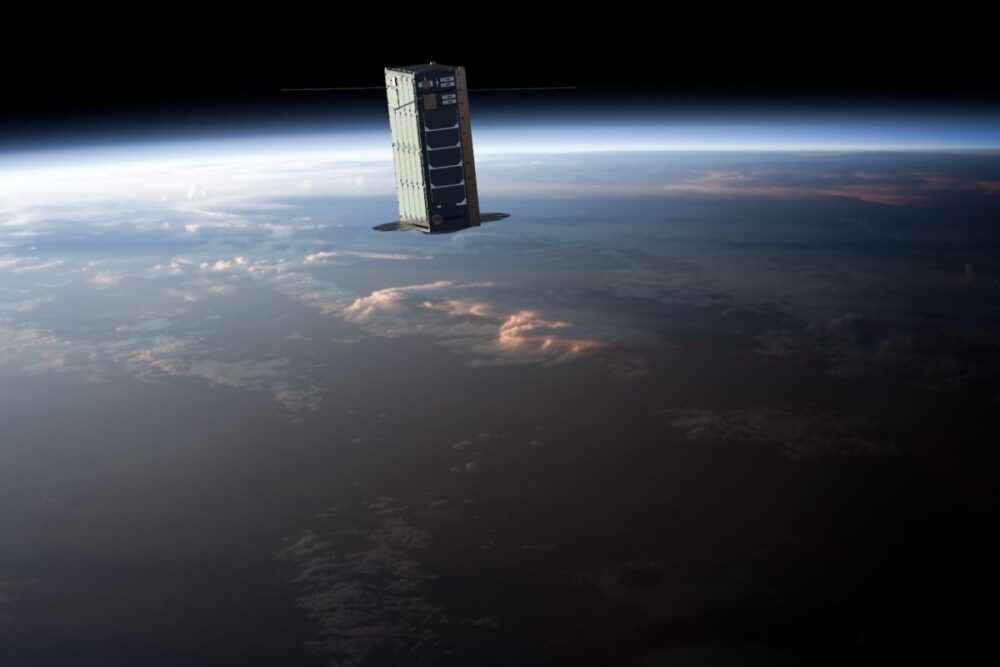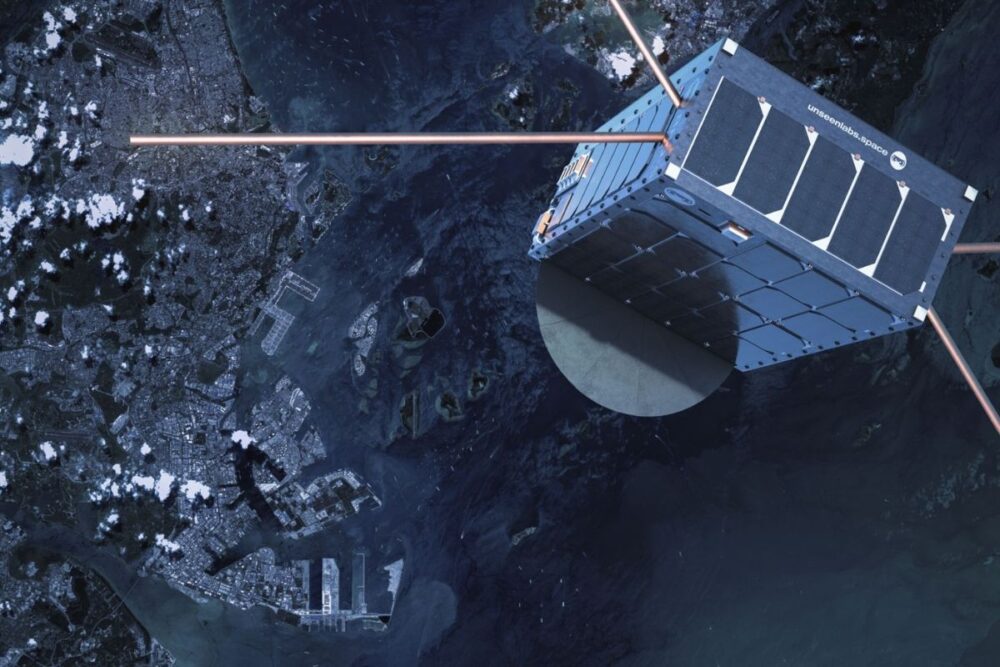The French start-up Unseenlabs is on a mission to bring transparency to the world’s oceans by detecting ships that don’t want to be found — even those trying to hide from radar and tracking systems. At Paris Air Show in Le Bourget, we spoke with Cannelle Gaucher, Communications Manager at Unseenlabs. She shared how the French startup is revolutionizing maritime surveillance using satellite technology.
Unseenlabs was founded in 2015 in French Britanny by two brothers. Clément Galic, CEO, is a software engineer with expertise in critical space and air traffic systems. Jonathan Galic, CTO, is a hardware and software specialist in Earth observation and defense satellite missions. Together, they’re driving Unseenlabs’ mission to revolutionize maritime surveillance from space.
Shedding Light on Invisible Ships From Space
“We started from a simple observation,” explains Cannelle Gaucher, Communication Manager at Unseenlabs. “There’s a huge lack of visibility at sea. One of our founders, Jonathan Galic, has a background in electromagnetic intelligence. He realized that if we could equip satellites with sensors capable of detecting electromagnetic waves from space, we could pinpoint maritime activity—even when ships try to disappear.”
With around 105,500 vessels in the global merchant fleet as of 2023 — from container ships to dry bulk carriers — and nearly 70,000 fishing vessels recorded in 2020, maritime surveillance faces enormous challenges.
Experts estimate that a ship’s position is unknown or incorrect 35% of the time. The AIS (Automatic Identification System), the main tool used for commercial vessel tracking, is mandatory for less than 3% of the global fleet. This means that most ships can operate freely at sea without being tracked.
The consequences are significant: 15–20% of the fish consumed globally comes from illegal fishing. 10,000 tons of oil are dumped into the ocean every year, with 99% of polluters never identified. Undersea cable sabotage is on the rise, often carried out by ships that deliberately switch off their AIS to avoid detection when they have an AIS equipment. And maritime piracy costs the global economy $25 billion annually.
Space-Based RF
That’s where space-based radio frequency (RF) comes in. Unseenlabs’ satellite detection system can geolocate and characterize the electromagnetic signatures of ship emitters — day or night, anywhere in the world, and regardless of weather conditions.
Vessels at sea embed numerous communication and navigation systems that emit electromagnetic signals. These are the signals that Unseenlabs aims to detect, characterize, and geolocate.
Their technology — the details of which remain confidential — produces a unique type of data that complements existing systems such as AIS, VMS, SAR, and optical imaging. The advantage of RF is its broad coverage area, unique vessel identification, and kilometer-level geolocation accuracy — even for non-cooperative targets.
Unseenlabs launched its first satellite in 2019. Just weeks after entering orbit, it was already delivering usable data. Fast-forward to 2025, and the company now operates a fleet of 16 proprietary satellites, with another launch imminent. Indeed, this June, the company will expand its existing constellation with a new satellite, BRO-18, which will be launched as part of SpaceX’s Transporter-14 mission.
These nanosatellites—each about the size of a shoebox—can detect electromagnetic emissions from any vessel with onboard electronics, including those that have switched off their cooperative identification systems such as AIS. This capability gives Unseenlabs a unique advantage:
“As soon as a vessel emits electromagnetic signals — which it does simply by operating electrical equipment, and today all ships have such equipment — it can be tracked,” says Gaucher. “Even if a vessel tries to hide, we’ll still detect its electromagnetic signature. That means we can track illegal fishing, smuggling routes, and other suspicious activity at sea.”
A Single-Satellite System
Unlike conventional geolocation technologies that rely on triangulation using multiple satellites, Unseenlabs’ innovation lies in its ability to geolocate emitters with a single satellite.
“This single-satellite system is one of our key advantages—it allows us to scan a 500-kilometer zone quickly and reliably without loss of data.”
The company’s RF intelligence system has proven valuable not just to defense forces, but also to commercial actors. Clients include navies, insurers, and shipping companies looking for enhanced maritime domain awareness. Their very first client was the French Navy.
The data can be delivered in various formats: geospatial maps, raw data files, or high-level analysis performed by Unseenlabs’ team of maritime analysts based in Brest, France.
“They interpret vessel behavior—movement patterns, proximity to certain zones—and flag possible illegal or dangerous activity,” Gaucher notes. “This information can even be used in legal proceedings.”
Cannelle told us that their system was for example able to track the movements of the Chinese vessel Y-Peng 3, a ship suspected of sabotaging several undersea cables in the Baltic Sea.
“We could clearly see that its behavior was abnormal, suspicious — that’s the power of radio-frequency detection,” she explained.
However, she also noted that their system can only detect what is above water — meaning it cannot track submarines.

Fully Independent and Security-Focused
Unseenlabs is fiercely independent and handles its entire technology stack—from satellite construction to data processing. The satellites are launched via SpaceX rockets, in partnership with integrators like Exotrail. The company also partners with global ground station networks to downlink the satellite data, which is then processed exclusively by French-based servers and teams. For the company, security and sovereignty are top priorities.
“The data never leaves our control until it’s securely delivered to clients,” Gaucher emphasizes.
Before sending data abroad, Unseenlabs must obtain an export license from the French authorities, particularly when clients are government agencies.
Despite growing geopolitical tensions in orbit, the company has avoided satellite collisions and cyberattacks thanks to advanced onboard security algorithms.
“We’ve never lost a satellite, and our systems are protected at the highest level of cybersecurity,” Gaucher says.
Each nanosatellite has an operational life of about 7 years, after which it naturally deorbits and disintegrates in the atmosphere—no space junk left behind.
READ ALSO
Scaling Up for Multi-Domain Surveillance
Backed by three fundraising rounds—including a recent €85 million investment in 2024—Unseenlabs is preparing for its next leap: a second, larger constellation set to launch in 2026. This new generation of satellites, ten times the size of the current ones, will extend coverage from maritime to terrestrial, aerial, and space surveillance.
“We’re going multi-domain while keeping RF intelligence at the heart of what we do,” says Gaucher. “The oceans were just the beginning.”
With more than 120 employees, new international offices (including a growing team in Singapore), and strong global demand, Unseenlabs is scaling fast—proving that even a small satellite can cast a long shadow over the opaque world of maritime operations.
In a sector traditionally dominated by defense giants, Unseenlabs stands out as a nimble private startup.
“We’re one of only two known operational players in the world capable of this kind of RF detection from space,” says Gaucher. “The other is American.”
To their knowledge, no Chinese system is publicly operational at this level.
Read our other stories from Paris Air Show






![Image [Buying Guide] How to Choose the Right Protection Gloves?](/wp-content/uploads/sites/3/Gloves-1-320x213.jpg)



